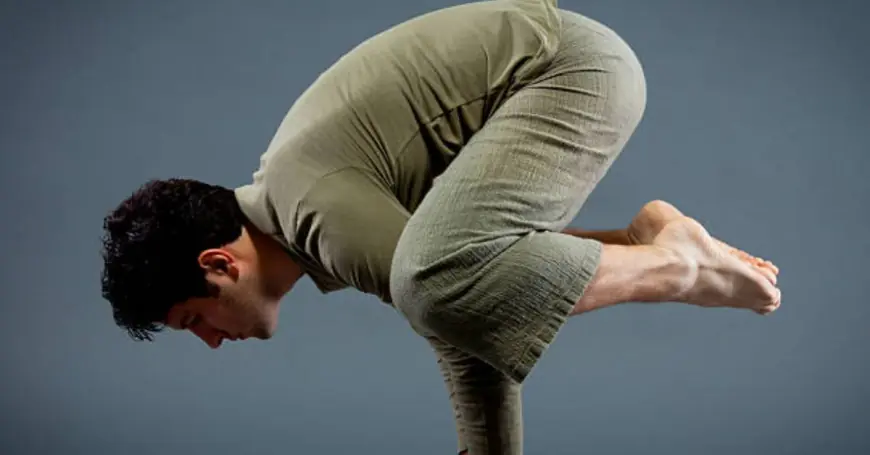Mastering Urdhva Kukkutasana: The Upward Rooster Pose
Urdhva Kukkutasana, also known as Upward Rooster Pose, is an advanced arm balance in yoga that demands strength, flexibility, and focus. Rooted in the traditions of Ashtanga yoga, this pose combines elements of lotus posture with powerful core and arm engagement, making it both a physical and mental challenge. Whether you're exploring arm balances for the first time or deepening your practice, Urdhva Kukkutasana offers a unique opportunity to cultivate balance and inner stillness.

Urdhva Kukkutasana, or Upward Rooster Pose, is a powerful and challenging yoga asana that combines strength, balance, and flexibility. It is often practiced in advanced yoga sequences, particularly within the Ashtanga Yoga system. This arm balance pose demands a deep understanding of body alignment, core engagement, and the ability to maintain mental focus under physical strain.
The Meaning Behind Urdhva Kukkutasana
The Sanskrit term breaks down as follows:
-
"Urdhva" means "upward"
-
"Kukkuta" means "rooster"
-
"Asana" means "pose"
The pose is named after the posture a rooster might take when lifting itself proudly and powerfully, symbolizing alertness, vitality, and a strong grounding in the present moment.
How to Prepare for Urdhva Kukkutasana
Because Urdhva Kukkutasana is an advanced posture, preparation is key. Several foundational poses help build the strength and flexibility required:
-
Padmasana (Lotus Pose): This pose is essential, as Urdhva Kukkutasana begins in full lotus. Practitioners must have open hips and healthy knees.
-
Bakasana (Crow Pose): Crow helps develop wrist strength and teaches the mechanics of arm balancing.
-
Navasana (Boat Pose): Builds core strength which is crucial for lifting the body off the ground in this pose.
-
Chaturanga Dandasana: Helps condition the upper body and stabilize the shoulders.
A solid warm-up targeting the wrists, hips, and core is vital before attempting Urdhva Kukkutasana.
How to Perform Urdhva Kukkutasana
-
Begin in Padmasana (Lotus Pose): Sit with legs crossed in full lotus. Take a moment to ground yourself and connect with your breath.
-
Place your hands on the floor: Position your palms firmly on the mat, shoulder-width apart, just in front of your hips.
-
Engage your core and arms: Lean forward slightly, shift your weight into your hands, and press down to lift your knees and hips off the mat.
-
Lift into the balance: With control, lift the entire lotus-bound lower body upward, balancing entirely on your hands. Keep your elbows bent slightly and hug them in to create stability.
-
Hold and Breathe: Stay in the pose for 3–5 breaths, focusing on balance, breath, and alignment.
-
Exit Mindfully: Gently lower yourself back to the mat with control.
Benefits of Urdhva Kukkutasana
Practicing Urdhva Kukkutasana offers a wide range of physical and mental benefits:
-
Strengthens the arms, shoulders, and core
-
Improves balance and body awareness
-
Enhances concentration and mental clarity
-
Promotes hip flexibility and joint mobility
-
Develops resilience and inner calm through challenge
This pose also has symbolic meaning—it teaches practitioners how to rise up with strength and grace, even in difficult situations.
Common Challenges and Tips
-
Wrist Pain: Strengthening and properly warming up the wrists can help. Wrist stretches and wrist-strengthening drills are recommended.
-
Fear of Falling: Practice near a wall or with the guidance of a teacher when starting out. Using props like blocks under the hands can also help reduce the fear.
-
Tight Hips: If full lotus is not yet accessible, work consistently on hip openers before attempting Urdhva Kukkutasana.
Final Thoughts
Urdhva Kukkutasana is not just a test of physical strength—it’s a true embodiment of focus, patience, and determination. While the pose may look intimidating, approaching it step-by-step and incorporating supportive poses into your regular practice will gradually build the foundation needed for success. As with any advanced posture, consistency, humility, and mindful practice are key.
Whether you achieve full expression of Urdhva Kukkutasana today or several months from now, the journey toward it will deepen your understanding of your body, mind, and yoga practice as a whole.
What's Your Reaction?
 Like
0
Like
0
 Dislike
0
Dislike
0
 Love
0
Love
0
 Funny
0
Funny
0
 Angry
0
Angry
0
 Sad
0
Sad
0
 Wow
0
Wow
0


















































